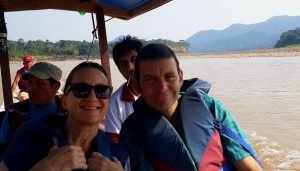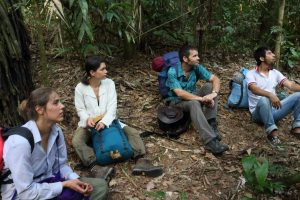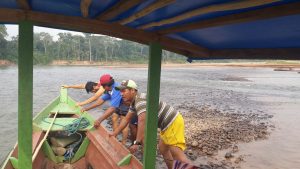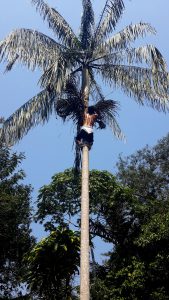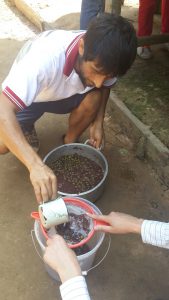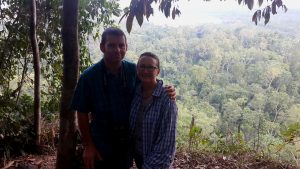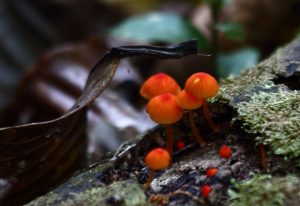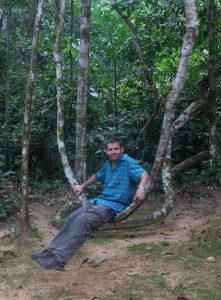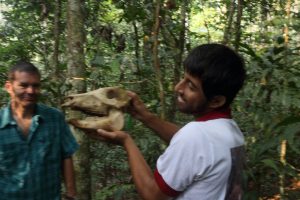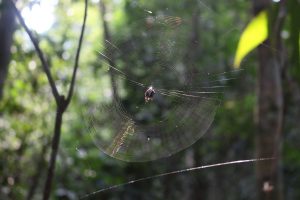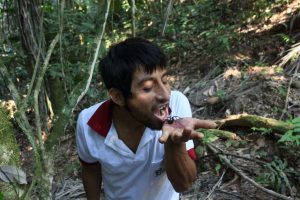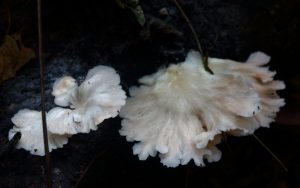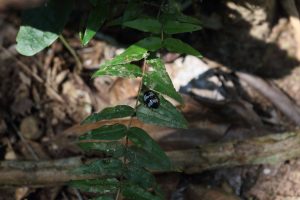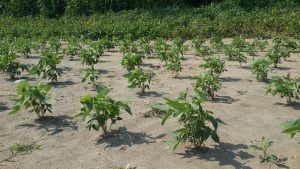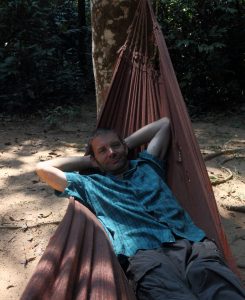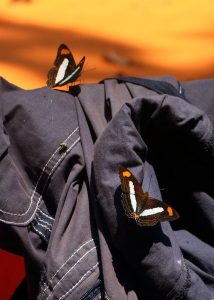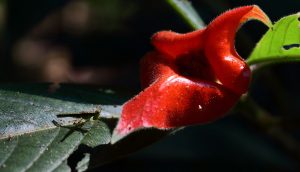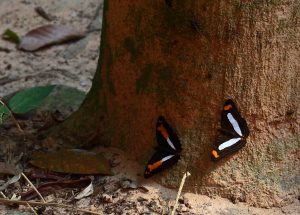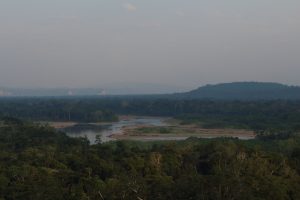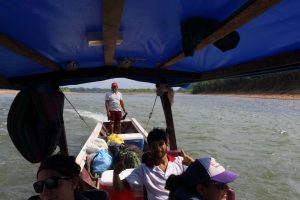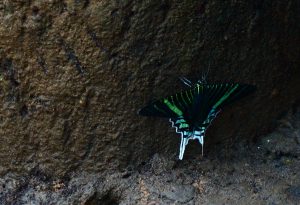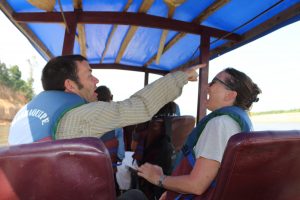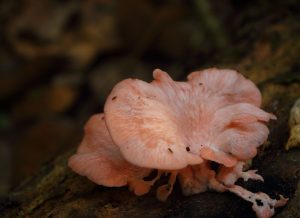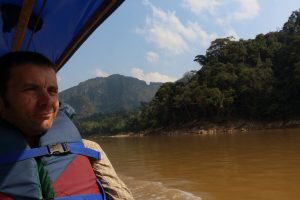Amazon… the well-known patch of rainforest rather than a profitable on-line retailer. We’re in the Bolivian bit of it known as the Madidi; the most southerly extent of the vast Amazon Basin. To get there we go from Death Road to Rurrenabaque. It’s hot, humid and of course, jungly (see route map).
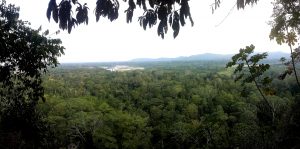
There’s a lot of trees in Madidi
Death Road to Rurrenabaque
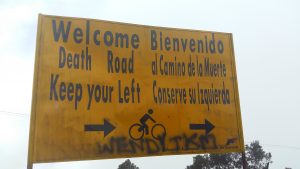
Death Road… mostly bikes these days
To get to said Madidi, we drove the loooong and dire road from La Paz to Rurrenabaque. On the way we passed the famous ‘Death Road’. It won’t stretch your imagination to hear that this is a particularly dangerous stretch of road, so named when the UN announced that more deaths had been recorded for this road than any other in the world. Death Road now has a safer alternative route running down the opposite side of the valley, with the original road now mostly left for tourist bike tours.
Hundreds of mountain bikers now career daily down the route on organised excursions from La Paz. If you don’t mind tangling with all the cyclists you can still drive Death Road but from our view across the valley from the new road, it didn’t look any worse than several other routes we have driven in Bolivia and Peru. The mountain road north of Cochabamba in Bolivia and the PE-3N south of Quiruvilca in Peru are both far worse than Death Road.
Jungle Trek
Some 9 hours of mostly rough driving beyond Death Road is Rurrenabaque. This remote town on the edge of the jungle is the jumping-off point for trips into the Madidi rainforest, but in addition to this ‘claim to fame’ we would add the Paris Bakery. Unlikely as it may seem, Rurrenabaque is the home of a Parisian master-baker. We’d go out on a limb and say that he bakes the best bread, pastries and chocolate brownies in Bolivia, but that’s setting a pretty low bar, so we’ll say … in South America, no… in the world! 🙂
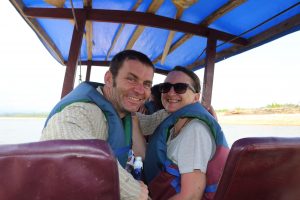
Heading out on the long-boat
Beyond Rurrenabaque, several hours by long-boat down the river, are several options for trips and treks into the jungle. Some stay in (relatively) up-market lodges to relax in the rainforest environment. Others stay in simpler camps for a more ‘authentic’ jungle experience. Both of these options provide for jungle walks around the camp areas to look for critters however, the jungle is so dense that you are far more likely to hear, rather than see many real-live critters crossing your path. So we decided on a nomadic option for our trip: a four-day trek circuit.
This trip doesn’t focus on looking for wildlife but rather on taking a journey to understand the jungle a little; learning about the plants, the foods and the rainforest way of life. Camping is at a different spot each night and we get to do a bit of rafting too! If we see some wildlife on the way it will be a ‘Brucie Bonus’, but it’s not our mission to hunt sightings of critters which only rarely show their faces.
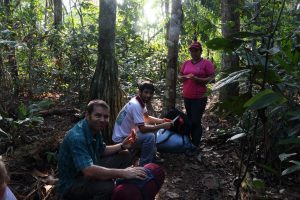
Taking a break with Darwin and Leni
The trek company Mashaquipe, introduced us to our guide whose name, rather encouragingly, is Darwin (so he should know a thing or two about nature 🙂 ). Darwin was assisted by our cook Leni and we were teamed-up with two Dutch tourists who had also booked the trek, so there was a total of six in our team. We first headed a few hours up-river on a long boat to the main base-camp.
The river’s a bit low at this time of the year and the boat got a bit stuck on pebble-banks – nothing that a bit of brute force from the boat crew couldn’t deal with. After one night at the base-camp, the six of us stuffed our rucksacks with sleeping bags and mosquito nets and headed deeper into the jungle on foot. We tourists carried our own gear and water, but Darwin had the mammoth task of carrying not only his own gear, but also the food supplies for the six of us! Not only this, but he did so with a make-shift rucksack that he had fashioned himself from a hessian sack and an old pairs of jeans for the straps! A bad-back-in-waiting, me thinks!
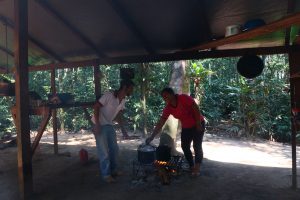
Darwin & Leni cooking delicious nosh in the jungle kitchen
The distances that we covered between camps were not huge, but carrying our stuff in the heat and humidity over sometimes rough jungle paths, climbing over huge fallen trees and crossing streams, it wasn’t easy going. Sometimes we walked for a few hours through dense trees and Tarzan vines, then suddenly reached an open point on a hill-top to see the most amazing view of jungle into the distance, with parrots and macaws swooping above the tree-top canopy below us.
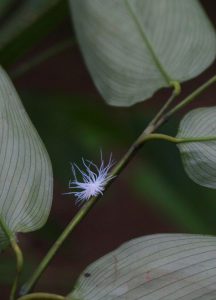
The white fluff is an insect, crawling up the branch
We stopped for frequent breaks where Darwin explained about the insects, the plants and their uses by the indigenous people. Marcus was even brave enough to sample some of the live ants and termites (the witchetty-grub scene from Crocodile Dundee movie sprang to my mind 🙂 ). On the way we also collected leaves, tree bark and berries to make traditional teas and fruit juices when we arrived at the camps. Of wildlife, we saw many brightly coloured birds, butterflies, insects, spiders (tarantulas!) and occasionally the odd monkey swinging above us in the canopy (all of which, incidentally, pose a frustrating challenge to photograph in the jungle canopy!) but as we had been warned, we heard far more animals than we saw. These sounds are particularly exciting at dawn, lying under the mosquito net watching the sky lighten above the tree-tops and listening to the rainforest come to life.
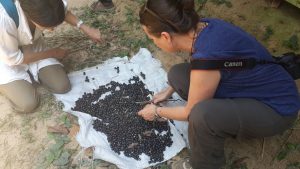
Sorting acai berries
Twice whilst walking we could smell and hear wild pigs snuffling in the undergrowth not far away. We dropped our rucksacks in a pile and diverted from our course to look for them. Darwin moved expertly and almost silently through the bush towards them, but our comedy-like lack of stealth crashing clumsily through the jungle-floor debris behind him caused the pigs to scarper before we could get a proper sight of them. Not a wholly successful exercise, but we did catch a glimpse as scores of them scuttled off into the bush grunting, and it was fun trying to track them down.
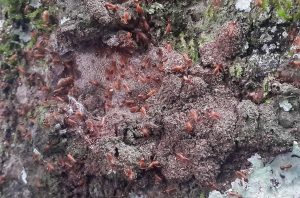
Tree turmites (Marcus’ energy-snack!)
Darwin’s knowledge of the jungle environment is impressive. He mimicked so many sounds of the wildlife and occasionally seemed to have almost Dr Doolittle-style conversations with the birds and monkeys as we walked along 🙂 His stories and explanations really gave us an insight into life in the rainforest.
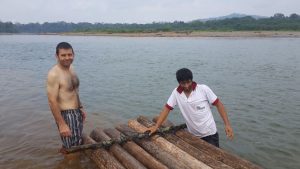
Raft building
On day four our trek-loop brought us back to the river. From here our mission was to build a raft to float some kilometres back down the river to Mashaquipe’s base-camp. The trek organisers had conveniently left some balsa-wood logs on the shore for us to use. However, having made a realistic pre-assessment of our raft-building skills, they also kindly sent a boat to collect our rucksacks so that we didn’t have to risk taking all our stuff on our dodgey raft. Our raft wasn’t quite the Kon-tiki, but it took our combined weight and saw us safely paddling for a couple hours down-stream back to base-camp. From here we caught the long-boat back to Cuthbert in Rurrenabaque.
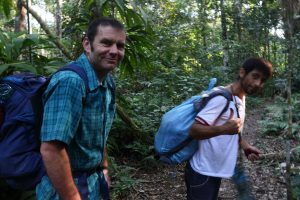
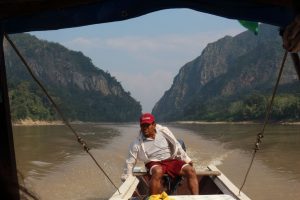
Long-boat captain
Looking back, the trek wasn’t an easy-ride but we really enjoyed it. Moving-on to a different camp each day created a real sense of adventure and we are glad that we didn’t succumb to the tempting marketing-spiel of other companies offering stays in the more comfortable single-site camps. The make-shift nature of our camps meant that we had only the most basic ablution facilities (i.e. hole in ground). Washing/bathing was in cold, but beautifully crystal-clear streams. To stay safely above the ground-creepy-crawlies we slept on tressell-platforms under mosquito nets. Our sleeping bags were clean and dry when we were given them, but they absorbed the humidity and became damp to sleep in (actually it was mostly so hot that we only used them as base-mats anyway).
Our cook, Leni hiked dutifully behind us all the way around the trek and did a great job catering for us in very basic field-kitchen conditions. Her food was always good and plenty of it. Both Darwin and Leni really took care of us, doing everything they could to make things as comfortable and enjoyable for us as possible. The only caveat that we would add for anyone thinking of doing this trip is to consider the season: now is the driest time of the year. It’s quite humid, but the jungle floor is mostly firm and quite dry. We had only a couple of light showers of rain and the mosquitoes were (just about) tolerable. The wet season would be a very different story, requiring wellies, a waterproof poncho and a lot of extra mossie repellent! 🙂
Mud-slide
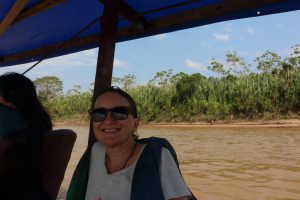 So we returned to Rurrenabaque on the edge of the jungle and decided to stay-put for a few more days. We’d found a great camp for Cuthbert on the hillside overlooking the town, with a lovely pool for relaxing. We had some more required-sampling of the Parisian bakery, plus a stack of laundry to get done. We were quite enjoying our chill-out time jungle-side but eventually some unseasonally heavy rains came. The locals were surprised by this in the dry season, but we were just thankful that it hadn’t started a few days before. The wet conditions would have made for a miserable experience in the kind of make-shift jungle camps that we had enjoyed. Narrow escape there, phew!
So we returned to Rurrenabaque on the edge of the jungle and decided to stay-put for a few more days. We’d found a great camp for Cuthbert on the hillside overlooking the town, with a lovely pool for relaxing. We had some more required-sampling of the Parisian bakery, plus a stack of laundry to get done. We were quite enjoying our chill-out time jungle-side but eventually some unseasonally heavy rains came. The locals were surprised by this in the dry season, but we were just thankful that it hadn’t started a few days before. The wet conditions would have made for a miserable experience in the kind of make-shift jungle camps that we had enjoyed. Narrow escape there, phew!
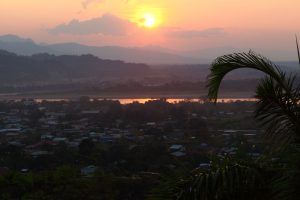
Great sunset from Cuthbert’s camp above Rurrenabaque
The torrential rains finally made our decision to extract ourselves from the jungle-zone. Our plan (with the benefit of hindsight, we can call this ‘Plan A’) is to retrace our route part of the way back towards La Paz, then at the town of Caranavi, cut north on some winding mountain tracks across to Lake Titicaca and into Peru. This we know will be a long and slow route, but we’re in no hurry and are reluctant to retrace our route all the way back to La Paz. So off we set. Obviously we have stocked up with the French chocolate brownies to see us on our way, but the slight snagette is that part of the route is currently undergoing roadworks: closed 07:00 – 17:00 hrs. It is extremely rare that we break our self-imposed rule against driving after dark, but here needs must.
As we head over the hills rising gently from the rain-forest plain towards the altiplano, we enter the dense pea-soup of the (very low) cloud base in which we can barely see beyond Cuthbert’s bonnet. Brit readers will be more than familiar with this ‘fog thing’, but it’s many years since we have seen it and it’s not a welcome experience on rough, muddy, remote Bolivian hill-side roads.
Darkness falls and, by way of a reminder as to why we choose ‘never’ to drive at night, we see that only every other driver is familiar with the concept headlights. Buses are parked unlit in the carriageway, there are many animals in the road, not to mention the swerving cyclists and dark-clad pedestrians wandering aimlessly around the shadowy verges. It’s like some spooky arcade-game to see how many ‘almost invisible’ targets you can miss! The rough road deteriorates further, the rain still rains, the mud is gets deeper and we continue to dip in and out of pea-soup visibility.
By around 20:30 hrs we pull up behind a succession of trucks that appear to have been randomly abandoned across the road. Marcus gets a torch and goes out to investigate: 300m down the road, a large mud-slide blocks the route. Clearly nobody is getting through here tonight! The back-log of vehicles stacked at random angles across the road behind us gets longer. They are mostly lorries, but there are also several cars with families and mini-buses crammed with all ages. They have struggled through the mud to get this far and are unable to turn back due to the chaotic ‘parking’ of trucks all over the narrow road behind them. Seeing the mud-bank ahead, most people climb back into their vehicles and settle down for the night as the rain continues… We do the same, except we are fortunate to have the comfort of Cuthbert… such a little star!
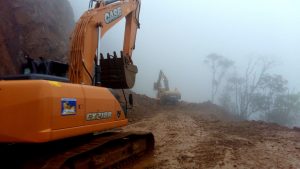
Mud-movers at work
At dawn we don our wellies and venture outside to check-out the mud situation. It seems that the nearby roadworks may have been at least partly to blame for the land-slide. The plus-side to this is that there are large diggers nearby able to clear the blockage. They start at first-light and within a couple of hours there is a single-carriageway clear path. This now only leaves the battle-royal as which traffic direction gets to go through the gap first! Patience is the key here… luckily we were fairly near the front of the queue. We soon on our way crawling the rest of the way to Caranavi between the lorries.
Eventually at Caranavi we stop for fuel. We’re warned by the staff that our ‘Plan A’ route heading cross-country north towards Lake Titicaca isn’t a good idea. Rains up there have been very heavy causing more mud-slides on the steep, narrow tracks. No locals would attempt the route in this weather… hmmm we’d be a bit foolish to ignore the warning. So a disappointing ‘Plan B’ was hatched… we’d have to route all the way back to La Paz 🙁 . Up the Death Road valley the visibility deteriorated badly again, but eventually as we crested the 4,600m ridge overlooking La Paz city… Hey Presto! Sunshine :-). Every cloud has a silver lining!
Link to next blog: Titicaca and Out Link to full South America Blog
Amazon and Mud Gallery
- Tree termites (Marcus’ energy-snack!)
- Sorting acai berries
- Raft building
- The white fluff is an insect, crawling up the branch
- Darwin & Leni cooking delicious nosh in the jungle kitchen
- Taking a break with Darwin and Leni
- Heading out on the long-boat
- Long-boat captain
- Great sunset from Cuthbert’s camp above Rurrenabaque
- Mud-movers at work
- Death Road… mostly bikes these days

